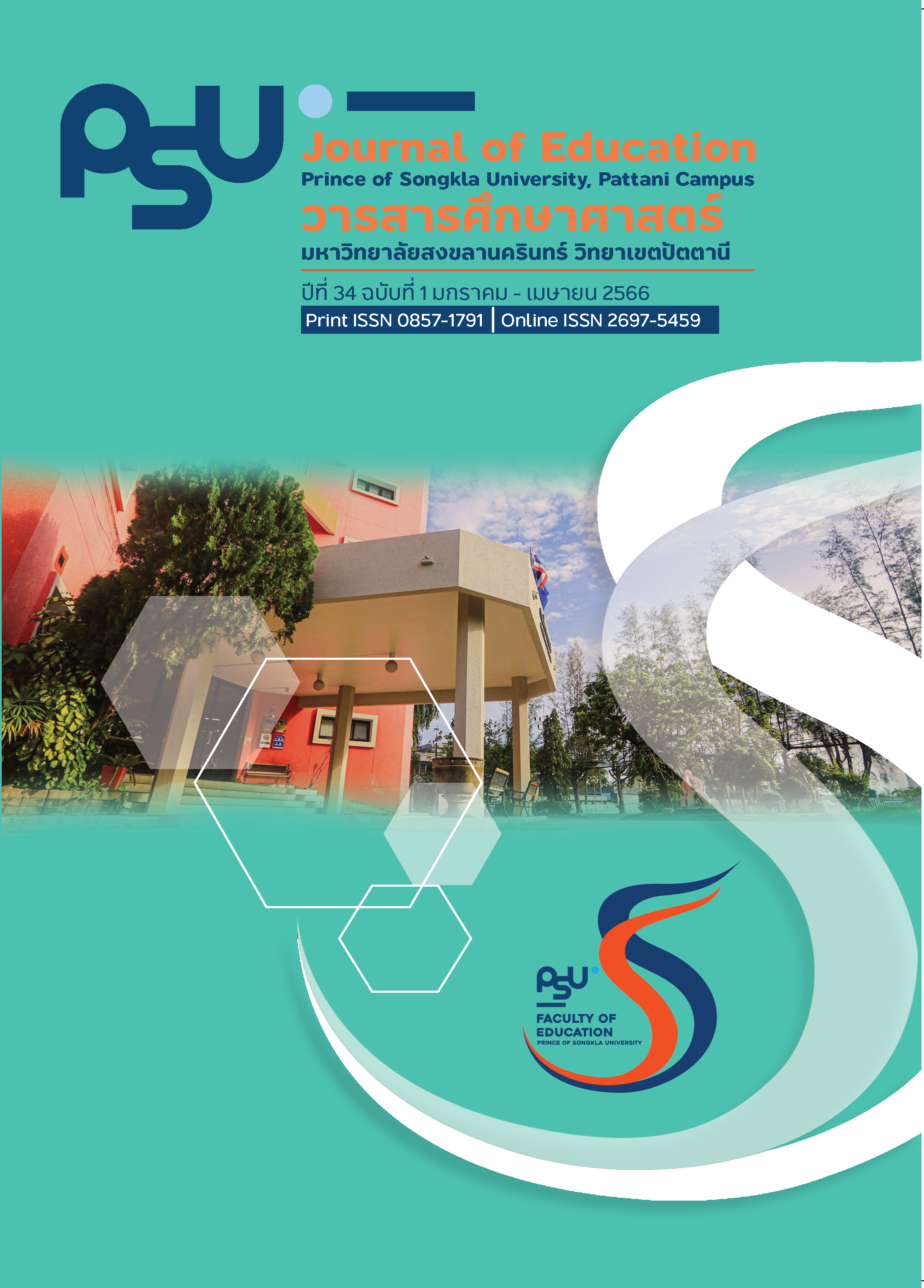ความสัมพันธ์ระหว่างความเครียดกับสุขภาวะทางจิต 5 องค์ประกอบ ของนักศึกษาฝึกประสบการณ์วิชาชีพครูของนักศึกษามหาวิทยาลัยราชภัฏ ในเขตภาคกลางและปริมณฑล
Main Article Content
บทคัดย่อ
การวิจัยนี้มีวัตถุประสงค์เพื่อ 1) ศึกษาความสัมพันธ์ของความเครียดกับสุขภาวะทางจิต 5 องค์ประกอบของนักศึกษาฝึกประสบการณ์วิชาชีพครูของนักศึกษามหาวิทยาลัยราชภัฏ 2) ศึกษาตัวแปรสุขภาวะทางจิต 5 องค์ประกอบที่สามารถพยากรณ์ความเครียดของนักศึกษาฝึกประสบการณ์วิชาชีพครูของนักศึกษามหาวิทยาลัยราชภัฏในเขตภาคกลางและปริมณฑล และ 3) สร้างสมการพยากรณ์ความเครียดของนักศึกษาฝึกประสบการณ์วิชาชีพครูของนักศึกษามหาวิทยาลัยราชภัฏในเขตภาคกลางและปริมณฑล กลุ่มตัวอย่างจำนวน 502 คน โดยสุ่มแบบหลายขั้นตอน (Multi-stage sampling) และกำหนดขนาดของกลุ่มตัวอย่างด้วยตารางสำเร็จรูปของเครจซี่และมอร์แกน เครื่องมือในการวิจัยได้แก่ แบบสอบถามข้อมูลทั่วไป มาตรวัดการรับรู้ความเครียด และมาตรวัดสุขภาวะทางจิต 5 องค์ประกอบ วิเคราะห์ความสัมพันธ์และหาตัวพยากรณ์โดยสัมประสิทธิ์สหสัมพันธ์เพียร์สัน และสถิติวิเคราะห์การถดถอยพหุคูณ
ผลการวิจัยพบว่า 1) สุขภาวะทางจิต 5 องค์ประกอบมีความสัมพันธ์ทางลบกับความเครียดของนักศึกษาฝึกประสบการณ์วิชาชีพครูอย่างมีนัยสำคัญทางสถิติที่ระดับ .01 โดยมีค่าสัมประสิทธิ์สหสัมพันธ์ตั้งแต่ -.150 ถึง -.498 2) ได้ตัวพยากรณ์ 5 ตัว คือด้านตัวตนที่สร้างสรรค์ ด้านตัวตนที่เผชิญปัญหา ด้านตัวตนที่สัมพันธ์กับสังคม
ด้านตัวตนที่เป็นแก่นแท้สำคัญ และด้านตัวตนที่เกี่ยวข้องกับสุขภาพร่างกาย ที่ร่วมกันพยากรณ์ความเครียดของนักศึกษาวิชาชีพครูอย่างมีนัยสำคัญทางสถิติที่ระดับ .01 โดยมีค่าอำนาจในการพยากรณ์ร้อยละ 26.8 มีความคลาดเคลื่อนมาตรฐานการพยากรณ์เท่ากับ 1.69 และ 3) ได้สร้างสมการพยากรณ์ความเครียดของนักศึกษาฝึกประสบการณ์วิชาชีพครูในรูปแบบคะแนนดิบและคะแนนมาตรฐาน ดังนี้
Y’ = 38.189–2.63(Crt_Self) – 6.56(Cop_Self) + .44(Soc_Self) + 2.07(Ees_Self) + .10(Phy_Self)
Zy’ = -.21(Crt_Self) –.51(Cop_Self) + .04(Soc_Self) + .17(Ees_Self) + .01(Phy_Self)
Article Details

อนุญาตภายใต้เงื่อนไข Creative Commons Attribution-NonCommercial 4.0 International License.
เอกสารอ้างอิง
Abouserie, R. (1994). Sources and levels of stress in relation to locus of control and self-esteem in university students. An International Journal of Experimental Educational Psychology, 14(3), 323-330.
Brink, M.T., Lee, H. Y., Manber, R., Yeager, D.S., & Gross, J. J. (2020). Stress, sleep, and coping self-efficacy in adolescents. Journal of Youth and Adolescence, 50(3), 1-21.
Boonsrangsom, W. (2013). The Relationship between perceived stress and happiness of university students with self-compassion as mediator. [master’s thesis, Chulalongkorn University]. The Chulalongkorn University Intellectual Repository. [in Thai]
Dawson, E. C. R. (2004). The relationship of stress levels to wellness practices among community college presidents. [Doctoral dissertation, East Tennessee State University]. East Tennessee State University Knowledge Bank.
Dilokkunanant, T. (2017). Work related stress, social support, and resilience among emergency nurses working in unrest areas of the southern border provinces. [Master's thesis, Prince of songkla university]. PSU Knowledge Bank. [in Thai]
Iamprasert, S., et al. (2003). Differences of sex, class, year and field of study on stress levels and Stress management of Chulalongkorn University students. Chulalongkorn University. [in Thai]
Krejcie, R. V. & Morgan, D. W. (1970). Determining Sample Size for Research Activities. Educational and Psychological Measurement, 30(3), 607-610.
Langer, A., Lawrence, E., & Barry, R. A. (2008). Using a vulnerability-stress-adaptation framework to predict physical aggression trajectories in newlywed marriage. Journal of Consulting and Clinical Psychology, 76(5), 756–768.
Lawson, G., Venart, E., Hazler, R. J., & Kottler, J. A. (2007). Toward a culture of counselor wellness. Journal of Humanistic Counseling, Education, and Development, 46(1), 5-19.
Matthews, D. (2019). Creative Self-Expression for Health, Coping, and Resilience. https://www.psychologytoday.com/us/blog/going-beyond-intelligence/201909/creativeself-expression-health-coping-and-resilience.
Mingprasert, A. (2014). Study of mental health and the stress of undergraduate students in Faculty of Pharmacy at Rangsit University. Journal of Social Science and Humanities, 40(2), 211-227. [in Thai]
Myers, J. E., & Sweeney, T. J. (Eds.). (2005). Counseling for wellness: theory, research, and practice. American Counseling Association.
Salas, B. L., Rodríguez, V.Y., Urbieta. C. T., & Cuadrado, E. (2017). The role of coping strategies and self-efficacy as predictors of life satisfaction in a sample of parents of children with autism spectrum disorder. Psicothema, 29(1), 55-60.
Seaward, B. L. (2001). Managing stress: Principles and strategies of health and well-b eing. (3rd ed.). Sudbury, MA: Jones and Bartlett.
Selye, H. (1956). The stress of life. McGraw-Hill.
Sujaree, T. (2008). Factors Affecting Practical Training Efficiency of English Program Students, Faculty of Humanities and Social Sciences, Rajabhat Maha Sarakham University. Rajabhat Maha Sarakham University Journal, 2(2), 129-138. [in Thai]
Suanrueaung, P., Jorajit, S., & Phantusena, C. (2009). Stress Factors Affecing Stress and Stress Coping of Prince of Songkla University Undergraduate Students Hat Yai Campus. E-Journal of Social Sciences & Humanities, 15(2), 313-330. [in Thai]
Therdwongvorakun, S. (2004). Study of Adaptation and Mental Health of Students. Faculty of Engineering Kasetsart University, Kamphaeng Saen. [Master's Thesis, Srinakharinwirot University]. Srinakharinwirot University Institutional Repository. [in Thai]
Vongtangswad, S. (2016). The effect of individual existential-humanistic online counseling on wellness of undergraduates with neuroticism. [Doctoral dissertation, Chulalongkorn University]. The Chulalongkorn University Intellectual Repository. [in Thai]
Wright, T. A., & Cropanzano, R. (2000). Psychological well-being and job satisfaction as predictors of job performance. Journal of Occupational Health Psychology, 5(1), 84-94


